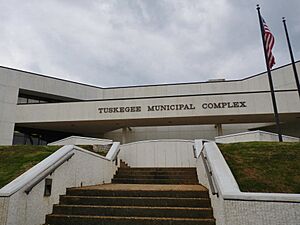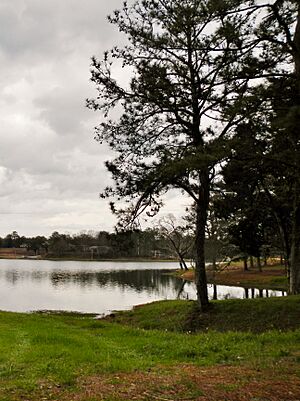Tuskegee, Alabama facts for kids
Quick facts for kids
Tuskegee, Alabama
|
|||
|---|---|---|---|
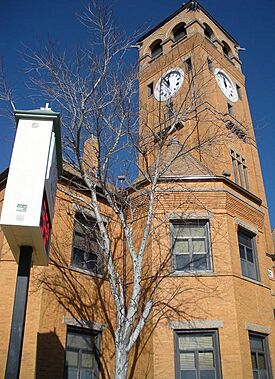
The Macon County Courthouse in Tuskegee was added to the National Register of Historic Places on November 17, 1987.
|
|||
|
|||
| Nickname(s):
Thou Pride of the Swift Growing South
|
|||
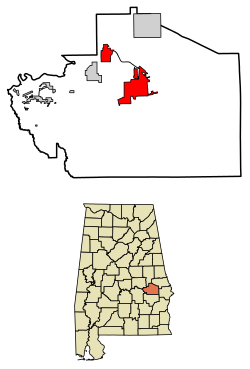
Location of Tuskegee, Alabama
|
|||
| Country | United States | ||
| State | Alabama | ||
| County | Macon | ||
| Founded | 1833 | ||
| Incorporated | February 13, 1843 | ||
| Government | |||
| • Type | Mayor–Council | ||
| Area | |||
| • City | 17.331 sq mi (44.887 km2) | ||
| • Land | 17.060 sq mi (44.185 km2) | ||
| • Water | 0.271 sq mi (0.702 km2) | ||
| Elevation | 463 ft (141 m) | ||
| Population
(2020)
|
|||
| • City | 9,395 | ||
| • Estimate
(2023)
|
8,765 | ||
| • Density | 513.85/sq mi (198.39/km2) | ||
| • Urban | 9,003 | ||
| • Metro | 18,370 | ||
| Time zone | UTC−6 (Central (CST)) | ||
| • Summer (DST) | UTC−5 (CDT) | ||
| ZIP Code |
36083
|
||
| Area code(s) | 334 | ||
| FIPS code | 01-77304 | ||
| GNIS feature ID | 0128211 | ||
| Sales tax | 11.5% | ||
Tuskegee (/tʌˈskiːɡi/ tuh-SKEE-ghee) is a city in Macon County, Alabama, United States. A general named Thomas Simpson Woodward founded the city in 1833. He was a veteran of the Creek War. Tuskegee became the main city of the county that same year. It officially became a city on February 13, 1843.
Tuskegee is the largest city in Macon County. In 2020, about 9,395 people lived there. By 2023, the population was estimated to be around 8,765.
Tuskegee has played a very important role in African-American history. It has also influenced the history of the United States since the 1800s. Before the American Civil War, the area had many cotton farms. These farms relied on enslaved African-American people to work.
After the war, many freedmen (formerly enslaved people) continued to work on farms. These farms mainly grew cotton. In 1881, the Tuskegee Institute was started. This school, now called Tuskegee University, was founded by Lewis Adams. He was a former slave who was allowed to get an education. The first leader of the school was Booker T. Washington. He became famous for helping to educate freedmen and their children.
In 1923, the Tuskegee Veterans Administration Medical Center was built. It was for the many African-American soldiers who fought in World War I. These facilities were separate for different races at the time.
The city was part of an important civil rights case in 1960. It was called Gomillion v. Lightfoot. The United States Supreme Court decided that the state had unfairly changed the city's borders. This change removed almost all black voters and residents from the city. The court said this was against the Fifteenth Amendment to the United States Constitution. The city's original borders were put back in 1961.
Contents
Understanding the Name Tuskegee
The name "Tuskegee" comes from the Spanish word "Tasquiqui." This word came from the Muskogee language, "Taskeke," which means "warriors." The original Native American town of Tasquique was located near the Chattahoochee River. This is just south of what is now Columbus, Georgia.
A Look at Tuskegee's Past
Early Beginnings of Tuskegee
The Creek people lived in this area for a long time. They had a settlement called Taskigi Town. In the 1830s, the U.S. government passed a law called the Indian Removal Act. This law forced most Creek groups to move from their homes. They were sent to an area west of the Mississippi River.
After the Creek people left, white farmers moved into the area. They came mostly from other Southern states. These farmers brought or bought enslaved African Americans. They used them to clear land and create cotton plantations. The invention of the cotton gin made growing short-staple cotton very profitable. This crop became the main product of the Deep South in the 1800s. Tuskegee became the main city in Macon County.
Late 1800s: Education and Change
In 1881, a young man named Booker T. Washington was hired. He was to start the Tuskegee Normal School for Colored Teachers. This school was built on an old plantation. Its goal was to train teachers for schools that were separate for black students. It also helped freedmen learn skills to support themselves. Washington created a program where students worked to learn trades. Over time, the school grew and added more programs. It later became Tuskegee University.
Washington believed in the power of education and self-improvement. The institute became known for teaching practical skills. Students gained work experience to prepare them for jobs in farming and other trades. These jobs were common in the small towns and rural areas where most students would return. Teaching was a respected job, as education was very important to freedmen. Washington thought that African Americans would gain acceptance by white Southerners as they improved their lives.
Washington led the school for many years. He built a network of wealthy white business owners who donated money. He also secretly helped pay for the legal defense of important civil rights cases. These cases challenged unfair laws that stopped African Americans from voting. Washington also worked with Julius Rosenwald to create plans for rural schools. These plans helped build more schools for black children in the South.
Early 1900s: Innovation and Service
One of the most famous teachers at Tuskegee was George Washington Carver. He was known for his amazing research into Southern farming. He developed hundreds of products from crops like peanuts and sweet potatoes.
During World War II, Tuskegee was home to the famous Tuskegee Airmen. These were the first African-American pilots trained in the U.S. Military. They served bravely in the war.
Today, Tuskegee University is a leading center for African-American education. The main part of the university is a National Historic Landmark District. It was added to the National Register of Historic Places in 1974.
The Tuskegee Veterans Administration Medical Center opened in 1923. It had 27 buildings on a large campus. It provided housing and a hospital for over 300,000 African-American veterans from World War I in the South. Doctors from top schools came to work there. Dr. Toussaint Tourgee Tildon, a Harvard Medical School graduate, was one of the first black doctors. He directed the hospital for 12 years. He helped the hospital get approval for a medical residency program.
In the 1930s, a group of black men in Tuskegee worked to register more black voters. This group later became the Tuskegee Civic Association (TCA). They worked hard to help more black people register to vote. But they often faced challenges that stopped them. The black community supported their efforts. The TCA also taught people about their civic duties. Many black community members wanted to change the unfair political system in Macon County. The group showed how few black people were able to register to vote. They even spoke to the United States Commission on Civil Rights.
Voting Rights Challenge: A Fight for Fairness
After the Civil Rights Act of 1957, activists made progress. They helped more black people register to vote in Tuskegee. For a long time, African Americans in Alabama could not vote easily. A state law from 1901 made it hard with things like a poll tax and literacy tests.
By 1957, about 1000 voters were registered. Around 400 of them were black voters, almost as many as white voters. But in the city, there were four times more African Americans than whites. Many of them were educated professionals working at Tuskegee Institute and the Veterans hospital. That year, the state government changed the city's borders. They made the city shape very strange, with 28 sides. This new shape left only ten black voters inside the city. It excluded 420 black voters, including all the staff from the Institute and the hospital. No white voters were excluded.
This law was meant to keep white people in control of the city. About 3,000 African-American residents protested the law. They also started an economic boycott of white businesses in the city. They called it a "selective buying campaign" because boycotting was illegal. It lasted about four years, and 26 white-owned businesses closed.
African Americans also fought the law in court. The NAACP supported their case, called Gomillion v. Lightfoot. At first, lower courts said the law was okay. But the US Supreme Court struck it down in 1960. The court said that changing the city borders based on race was unfair. It went against the Fifteenth Amendment to the United States Constitution. This amendment says that states cannot stop people from voting based on race. The unfair border changes were undone, and the city's old borders were restored in 1961.
This case was important for other civil rights cases. It was mentioned in Baker v. Carr (1964). In that case, the Supreme Court said that voting districts must be based on population. This led to the "one man, one vote" rule.
After the Voting Rights Case
In 1963, Tuskegee was supposed to be the first Alabama community to integrate its public schools. The school leader, C.A. Pruitt, at first did not want black students to join. But he worked with others to follow the court order. They planned to let 13 black students into the all-white high school in September 1963. However, Governor George Wallace tried to stop integration in Alabama. He said it would cause violence. The school was integrated on September 10, 1963. President John F. Kennedy sent the Alabama National Guard to help. Only 165 students started school that day, including the 13 black students. The total enrollment was usually about 550.
Johnny Ford was elected the first black mayor of Tuskegee in 1972. He served for six terms. Lucenia Williams Dunn became the first black woman mayor in 2000.
How Tuskegee is Governed
Today, Tuskegee has a council–manager government. This means a four-member city council, a mayor, and a city manager lead the city.
The city council makes the city's laws and rules. They also choose people for different city boards. Each council member is elected for a four-year term. They represent different areas of the city. Tuskegee also has one city council member who is elected by everyone in the city. This person serves as the mayor-pro tem. The mayor's job is to promote the city and talk with residents. The mayor also leads City Council meetings. So, the mayor's role in Tuskegee is mostly ceremonial.
Where is Tuskegee?
Tuskegee is in the middle of Macon County. It is located at 32°25′53″N 85°42′24″W / 32.43139°N 85.70667°W.
The U.S. Census Bureau says the city covers about 44.9 square kilometers (17.3 square miles). Most of this area is land, about 44.2 square kilometers (17.06 square miles). A small part, about 0.7 square kilometers (0.27 square miles), is water.
Tuskegee's Weather
Tuskegee has a humid subtropical climate. This means it has hot, humid summers and mild winters.
| Climate data for Tuskegee, 1991–2020 simulated normals (453 ft elevation) | |||||||||||||
|---|---|---|---|---|---|---|---|---|---|---|---|---|---|
| Month | Jan | Feb | Mar | Apr | May | Jun | Jul | Aug | Sep | Oct | Nov | Dec | Year |
| Mean daily maximum °F (°C) | 56.8 (13.8) |
61.2 (16.2) |
68.7 (20.4) |
75.7 (24.3) |
82.9 (28.3) |
88.3 (31.3) |
90.9 (32.7) |
90.1 (32.3) |
86.0 (30.0) |
77.0 (25.0) |
66.9 (19.4) |
59.2 (15.1) |
75.3 (24.1) |
| Daily mean °F (°C) | 45.7 (7.6) |
49.3 (9.6) |
56.1 (13.4) |
63.0 (17.2) |
71.1 (21.7) |
77.7 (25.4) |
80.6 (27.0) |
79.9 (26.6) |
75.2 (24.0) |
64.9 (18.3) |
54.5 (12.5) |
48.2 (9.0) |
63.9 (17.7) |
| Mean daily minimum °F (°C) | 34.5 (1.4) |
37.6 (3.1) |
43.5 (6.4) |
50.4 (10.2) |
59.4 (15.2) |
67.1 (19.5) |
70.2 (21.2) |
69.6 (20.9) |
64.4 (18.0) |
53.1 (11.7) |
42.1 (5.6) |
37.0 (2.8) |
52.4 (11.3) |
| Average precipitation inches (mm) | 4.87 (123.74) |
4.88 (124.04) |
5.15 (130.74) |
4.42 (112.36) |
3.82 (97.11) |
4.49 (113.96) |
4.92 (125.08) |
4.35 (110.46) |
3.68 (93.35) |
3.19 (81.14) |
4.19 (106.38) |
5.31 (134.95) |
53.27 (1,353.31) |
| Average dew point °F (°C) | 36.5 (2.5) |
39.0 (3.9) |
43.9 (6.6) |
51.3 (10.7) |
60.1 (15.6) |
67.5 (19.7) |
70.7 (21.5) |
70.2 (21.2) |
65.3 (18.5) |
55.0 (12.8) |
45.0 (7.2) |
39.9 (4.4) |
53.7 (12.0) |
| Source: PRISM Climate Group | |||||||||||||
Fun Places to Visit in Tuskegee
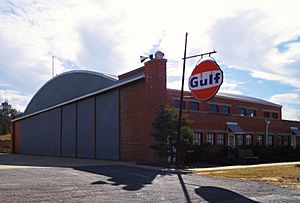
Downtown Tuskegee has many historical places. You can also visit the Tuskegee Visitor Center there.
Some cool places to see in and around Tuskegee include:
- Tuskegee University and the Tuskegee Institute National Historic Site. This includes places like the Oaks, Grey Columns, and the George Washington Carver Museum.
- Tuskegee Airmen National Historic Site at Historic Moton Field.
- Main Street Historic District and North Main Street Historic District.
- Tuskegee Human & Civil Rights Multicultural Center.
- Butler Chapel A.M.E. Zion Church. This church was a site of protests against the unfair city border changes in 1957.
- Tuskegee Veterans Administration Medical Center.
- The Tuskegee Repertory Theatre/Jessie Clinton Arts Center.
- Tuskegee City Lake, where you can fish, sail, and water ski.
- Tuskegee National Forest.
- Kirks Old Farm Museum.
Tuskegee's Population Over Time
| Historical population | |||
|---|---|---|---|
| Census | Pop. | %± | |
| 1850 | 1,563 | — | |
| 1880 | 2,370 | — | |
| 1890 | 1,803 | −23.9% | |
| 1900 | 2,170 | 20.4% | |
| 1910 | 2,803 | 29.2% | |
| 1920 | 2,475 | −11.7% | |
| 1930 | 3,314 | 33.9% | |
| 1940 | 3,937 | 18.8% | |
| 1950 | 6,712 | 70.5% | |
| 1960 | 7,240 | 7.9% | |
| 1970 | 11,028 | 52.3% | |
| 1980 | 13,327 | 20.8% | |
| 1990 | 12,257 | −8.0% | |
| 2000 | 11,846 | −3.4% | |
| 2010 | 9,865 | −16.7% | |
| 2020 | 9,395 | −4.8% | |
| 2023 (est.) | 8,765 | −11.2% | |
| U.S. Decennial Census 2020 Census |
|||
The table shows how the population changed. In 1957, the state passed a law that unfairly changed Tuskegee's city limits. This excluded almost all black residents. This caused the population to seem much lower in 1960. The city was sued in the case Gomillion v. Lightfoot (1960). The Supreme Court ruled against the state's action. The city's original borders were put back. This is why the population "increased" a lot by 1970. Since the late 1900s, the city and county have lost some people. This is because there are fewer job opportunities in the area.
In 2023, there were about 2,986 households in Tuskegee. Each household had about 2.21 people. The average household income was $38,160. About 26.9% of the people in the city lived below the poverty line. About 49.0% of the people had jobs. Also, 28.1% had a college degree or higher, and 86.5% had a high school diploma.
The main ancestry reported was English (98.4%). The average age in the city was 23.6 years old.
Tuskegee's People in 2020
| Race | Num. | Perc. |
|---|---|---|
| White | 171 | 1.82% |
| Black or African American | 8,863 | 94.34% |
| Native American | 18 | 0.19% |
| Asian | 59 | 0.63% |
| Pacific Islander | 4 | 0.04% |
| Other/Mixed | 174 | 1.85% |
| Hispanic or Latino | 106 | 1.13% |
According to the 2020 United States Census, there were 9,395 people living in Tuskegee. There were 2,936 households and 1,470 families.
Tuskegee's People in 2010
In the census of 2010, there were 9,865 people living in the city. There were 3,749 households and 1,956 families. The city had about 636.5 people per square mile. There were 4,624 homes, with about 298.3 homes per square mile. The city's population was mostly 95.8% Black or African American. About 1.9% were White, and 0.1% were Native American. About 0.5% were Asian, and 0.0% were Pacific Islander. About 0.3% were from other races, and 1.3% were from two or more races. About 1.3% of the people were Hispanic or Latino of any race.
Out of the 3,749 households, 21.3% had children under 18. About 19.0% were married couples. About 28.6% had a female head of household with no husband. And 47.8% were not families. About 40.1% of all households were single people. About 12.0% had someone living alone who was 65 or older. The average household had 2.17 people. The average family had 2.96 people.
The population was spread out by age. About 18.5% were under 18. About 27.8% were from 18 to 24. About 18.9% were from 25 to 44. About 21.7% were from 45 to 64. And 13.1% were 65 or older. The average age was 27.6 years. For every 100 females, there were about 78.8 males.
The average income for a household was $24,251. For a family, it was $43,472. Men earned about $40,653, while women earned about $26,631. The per capita income for the city was $15,471. About 22.2% of families and 31.6% of the population lived below the poverty line. This included 40.0% of those under 18 and 10.2% of those 65 or older.
News and Transportation
Local News
Tuskegee has one weekly newspaper. It is called The Tuskegee News. It has been published since 1865.
Getting Around Tuskegee
U.S. Route 29 and U.S. Route 80 go through Tuskegee. State Route 81 goes north from the city. About four miles north on Route 81, you can find the entrance to Interstate 85.
A little further past I-85 is a small village called Chehaw. Here, Southern Railway passenger trains used to stop. This was at the Western Railway of Alabama Depot. Until the mid-1960s, both the Southern's Crescent and its Piedmont Limited trains stopped there. The Crescent was the last train to stop at the station. The Southern Railway changed the train's route in 1970.
Famous People from Tuskegee
Many well-known people have connections to Tuskegee:
- Ajiona Alexus, actress; born in Tuskegee.
- George Washington Carver, agricultural scientist; died in Tuskegee in 1943.
- Sadie Peterson Delaney, chief librarian at the Veterans Administration Hospital.
- Tom Joyner, radio host; born in Tuskegee and went to Tuskegee University.
- Nella Larsen, nurse, librarian, and novelist; worked at Tuskegee Institute in 1915.
- Rosa Parks, born in Tuskegee; she became a famous civil rights activist in the 1950s. She helped lead the Montgomery bus boycott in Montgomery, Alabama.
- Lionel Richie, singer, songwriter, musician, and actor; born in Tuskegee.
- Robin Roberts, news anchor for Good Morning America; born in Tuskegee.
- Rory White, basketball player.
- Bill Winston, pastor, TV preacher, author, and business owner; born in Tuskegee.
- Sammy Younge Jr., civil rights activist; born in Tuskegee.
Sister Cities
 South Berwick, Maine, USA
South Berwick, Maine, USA
Images for kids
-
Tuskegee Post Office (ZIP code:36083)
-
A view of the Macon County Courthouse from the park in the town square. The Main Street Historic District was added to the National Register of Historic Places on March 12, 1984.
-
A statue of a Confederate soldier in the town square park. The pedestal reads: "Erected by The Daughters of the Confederacy to the Confederate Soldiers of Macon County".
-
The North Main Street Historic District was added to the National Register of Historic Places on March 7, 1985.
-
Built in 1857, Grey Columns now serves as the home of the president of Tuskegee University. It was added to the National Register of Historic Places on January 11, 1980.
-
The Butler Chapel African Methodist Episcopal Zion Church was added to the National Register of Historic Places on August 28, 1995.
See also
 In Spanish: Tuskegee (Alabama) para niños
In Spanish: Tuskegee (Alabama) para niños




